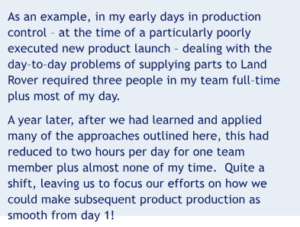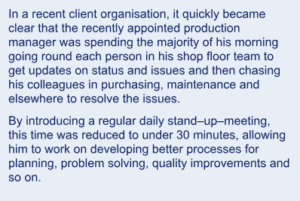Performance strategies – effortless excellence. Is achieving regular high performance taking too much effort? I remember one of my consulting colleagues telling me, early on in my transition from the corporate world into the life of a consultant, of a previous client who was a supplier to one of the major automotive manufacturers. They had been audited by the customer and were somewhat surprised to get a less than satisfactory report. “Why?” they asked. “Our delivery performance is excellent, quality exceeds requirements. What’s the problem?” The customer explained that, from their assessment, the level of effort required to achieve those results was excessive. It relied too much on managers ensuring that everything was done well, rather than being the outcome of a well-functioning system. A bit like the swan; everything looked smooth and serene yet, below the surface, there was a huge amount of frantic activity. Consequently, they said, it was too fragile and could not be relied upon to produce the results required consistently. They needed to change! The signs of such a “high effort” system aren’t difficult to spot. Much of the daily activity is focussed on dealing with “today’s problems” – chasing parts, adjusting schedules and so on. Managers are routinely working one or two levels “below” where they should be, as daily issues are escalated rather than being resolved at source. And, of course, when performance isn’t quite as required, this is compounded by the need to deal with the never-ending stream of enquiries from customers, sales staff and senior management for an update on progress on late deliveries. All of which leaves little or no time to work on the more strategic issues necessary for the future success of the business. Compare this situation with that at a truly high performing organisation such as Toyota, where they have an effective, integrated “production execution system”, itself part of an overall business system. In such an organisation, daily achievement of quality, delivery and cost performance is “routine with ease”. Everyone in the organisation has time to work on strategic issues and improvements. More than that, working life is generally easier and more satisfying for everyone – reduced stress, less need for extended working hours and so on.

Pic.1
Table of Contents
TogglePerformance Strategies – Everyone wants to do a good job!
“But surely that’s my job?!” I can imagine many readers – production managers especially – thinking at this point “but surely that’s the job?” And, of course, ensuring that customer requirements are satisfied is a key job requirement. Yet I pose the question, “should it have to be such hard work?” What if you had the confidence that everything that was planned to happen did happen, more or less “automatically”, without all the watching and chasing? This would then allow more time to work on improvements, develop people and think more strategically about developing the business for the future. In such an environment, everyone has confidence that others will do what is expected of them, when it is expected. I remember my great mentor, Ron, describing this as “shifting effort from the past to the future”, in other words from reacting to problems that had occurred to working on those actions that would prevent problems happening in the future. This may seem a far cry from where many businesses are today, so we will identify below the necessary building blocks to achieving this. A first response when things aren’t going well is often to point to the poor performance or attitude of others, often accompanied by comments such as “why can’t they just . . . . . ?” Underpinning these is surely a mindset that others are somehow less committed or motivated. Yet, I wonder, is there really a foundation for this? It is my belief that, with very few exceptions, everyone wants to do a good job and “stuff” gets in the way. So a great start point is an attitude shift to “assume positive intent” and work with others to work out what the “stuff” preventing good performance is and make it better.
An effective Production Execution System
“Eighty-five percent of the reasons for failure are deficiencies in the systems and process rather than the employee. The role of management is to change the process rather than badgering individuals to do better.” W. Edwards Deming
You may recognise this quote from Deming that builds on the above assumption. Once we have our mindset right, we can start to examine all of the components of “the system” for routinely executing the plan with ease and build on the foundations laid through the previous articles in this series. If one digs below the surface of what is commonly referred to as the Toyota Production System (TPS), a key idea is making it as easy as possible for everyone to do a good job. Of course, such a system covers a far wider range of topics than we are considering today, many of which have been covered in previous articles. In the rest of this article, we will unpack those elements that make the execution of the agreed, achievable production plan – what I refer to as a “production execution system” – a matter of an easy, albeit highly disciplined, routine that delivers on time, in full with no errors.
Make the invisible, visible
To do a good job, it is first essential for everyone to know what good looks like. Yet, all too often, when I ask teams in client organisations how they know they are doing a good job, I get responses like; “We don’t, we only find out when we aren’t.”
“It’s not enough to do your best; you must know what to do & then do your best.” W. Edwards Deming
So, a first pre-requisite is clarity for everyone on:
- What is required
- Why it matters
- How success will be measured
- “Boundaries” for autonomy, with an idea of delegating to the lowest possible level. For example, standard work instructions to be followed or triggers for when to flag issues upward.
As a side note, it is equally important to ensure that everyone has the means to succeed in terms of equipment, knowledge / skill and opportunity. While these may seem straightforward, it’s worth mentioning that ‘opportunity’ means more than simply time; there are the important dimensions on encouragement, feedback and coaching. All these aspects are discussed in more detail in an earlier article; “One thing you need to achieve everyday, everybody, everywhere improvement”.
Performance Strategies – Information at a glance
“Make your workplace into showcase that can be understood by everyone at a glance. In terms of quality, it means to make the defects immediately apparent. In terms of quantity, it means that progress or delay, measured against the plan, is made immediately apparent. When this is done, problems can be discovered immediately, and everyone can initiate improvement plans.” Taiichi Ohno, father of the Toyota Production System
A great way to do this is to create team information boards so that team members and managers alike can grasp quickly what is planned and how the team is performing against the plan. It’s important that these boards are seen as primarily for the team and their immediate managers to drive day-to-day action, and not for senior leaders to get a quick overview or to impress visitors (although, of course, both those things will occur too!) Typically, information on the boards will be generated by team members. This is generally through hand-written means (recognising “the power of the pen”), although effective electronic systems – that enable easier information gathering and sharing while maintaining the involvement of frontline workers – are increasingly used. This increases the sense of ownership and accountability as the team use the information to manage their own performance.

Pic.2
Cadence – a rhythm of routines and practices
The idea of a “drumbeat”, as used by the military for marching in time, is a great inspiration for having a regular rhythm of activity – hour-by-hour, day-by-day, week-by-week – to keep things on track. By this I don’t mean the rhythm of production activity itself, but the various activities and meetings that ensure that everything stays on track. As everyone starts to realise that things happen routinely, the more the operation of the system becomes “automatic” and happens with minimal effort. At the core of this is what is often referred to as the daily “stand-up” meeting. Team members gather round the information boards for a short (15–20mins), performance focussed meeting. Everyone necessary is represented, information is shared, issues identified and actions agreed. Depending on the size of the organisation, these meetings may happen at multiple levels (often referred to as a “tiered” structure”), to flow information upwards and escalate action items where necessary.

Pic.3
These meetings are highly interactive, involving and regularly led by team members – rather than team leaders and managers – to maintain the level of ownership and involvement. In a similar way, there will be a routine of weekly and monthly meetings covering topics such as agreeing the production planning, examining capacity vs. demand over the longer term, people development and so on.
Consistency of process – Standardised Work
Another key element is ensuring that routine, largely repetitive tasks are carried out the same way every time to ensure consistency, commonly referred to as standardised work.
“Standardised work is not to make all tasks repetitive; the intent is to define the best methods and to reduce variation in the work method as much as possible…”
Jeff Liker and David Meier
While this subject requires at least a full article on its own, there are a few points worthy of note:
- For standardised work to be effective, workers must “want to” follow the standardised work instructions, otherwise you’ll get the “only when someone’s looking” behaviour characteristic of some historical approaches.
- To achieve this, the workers are highly involved in creating the instructions and have the opportunity to improve them when difficulties are experienced or ideas to improve are identified.
- “Process confirmation” (rather than audit or assessment) is seen as a means to reinforce a positive culture and is accepted by workers as a means of gaining feedback and support. Hence, if they are not following the standard work, the conversation is around what is preventing them (understanding why, lack of knowledge or skill, process too difficult etc) and not about disciplinary action.
Problem Solving and Improvement
“[If] the new standard has been set up by the worker’s own volition, they take pride in the new standard and are willing to follow it. If, on the contrary, they are told to follow a standard imposed by management, they may not be as willing to follow it” Masaaki Imai, author of “Kaizen: the key to Japan’s competitive success Introducing such a “production execution system” will not result in an overnight change to the level of effort required to deliver high performance. What it will do is create a framework whereby all of the issues preventing “routine with ease” operation are brought to the surface so that they can be acted upon. Similarly, ideas for improvement can be captured. Once problems and opportunities are captured, there must be a “system” for prioritising, taking action and implementing any changes required as a result. In this way, the level of “effort” required to achieve high performance is progressively reduced and, in most cases, performance itself will improve and the business will develop and grow.
Managers doing the “right” job
It could be argued that managers working at a more strategic, forward–looking level is the first element of an effective production execution system, as a shift in management focus is needed to establish the various elements of the system. However, in many ways it becomes a result of putting all the above elements in place in a systematic way. As each of the other elements is put in place and becomes well established, everyone starts to spend less time on reactive tasks and more time on planned and forward-looking activities that drive continuous improvement and sustainable business success.
Performance Strategies – Ready for action?
Performance strategies – effortless excellence. Hopefully this article has helped you to identify any gaps in your organisation’s “production execution system”. However, you may be looking for more on how to put the various elements of an effective system in place. If that’s the case, a structured diagnostic visit may be a great first step. We’ll spend 2–3 hours on your site “walking the system” to see how you currently manage execution of your production plan. Based on our observations and conversations with your team, we will share our conclusions and recommendations for things to think about to make your system more effective. If you’re ready to book a diagnostic visit or simply want to find out a bit more, we’d love to talk to you. The goal of this visit is not to criticize, but to help you see where there might be opportunities to make your system more effective and efficient. The insights gained from this can lead to significant improvements in how your production system operates, reducing the effort required while maintaining or enhancing performance levels. We understand that change can be challenging, especially in well-established systems where certain practices have been in place for a long time. However, the benefits of a well-tuned production execution system are vast. Not only does it result in improved performance metrics, but it also leads to a more engaged and less stressed workforce. When employees see that their efforts are contributing to a smoothly running system and that their concerns and ideas are being heard and acted upon, their job satisfaction and productivity can soar.Remember, the journey towards a more effective production execution system is ongoing and iterative. It’s about making continuous improvements and not being afraid to question the status quo. It’s about shifting the mindset from a reactive to a proactive approach. It’s about empowering your team to solve problems at their source and creating an environment where everyone is striving for excellence. So, are you ready to take the next step towards operational excellence? If so, we’re here to guide you through the process, offering support and expertise every step of the way. Let’s work together to create a system that not only meets but exceeds your expectations. After all, your success is our success. Let’s make it happen, together.

Harvey Leach is passionate about helping organizations acquire the knowledge, skill, and culture they need to achieve Operational Excellence. Following a successful career in the automotive industry with Rover and BMW Group, where he worked in a variety of roles covering R&D, production and corporate strategy, Harvey has worked as a consultant, trainer, and coach since 2004. He delights in seeing teams “come alive” as they discover how they can apply the same principles that underpin some of the world’s leading companies to their organization to achieve impressive improvements in performance and more fulfilling lives.






